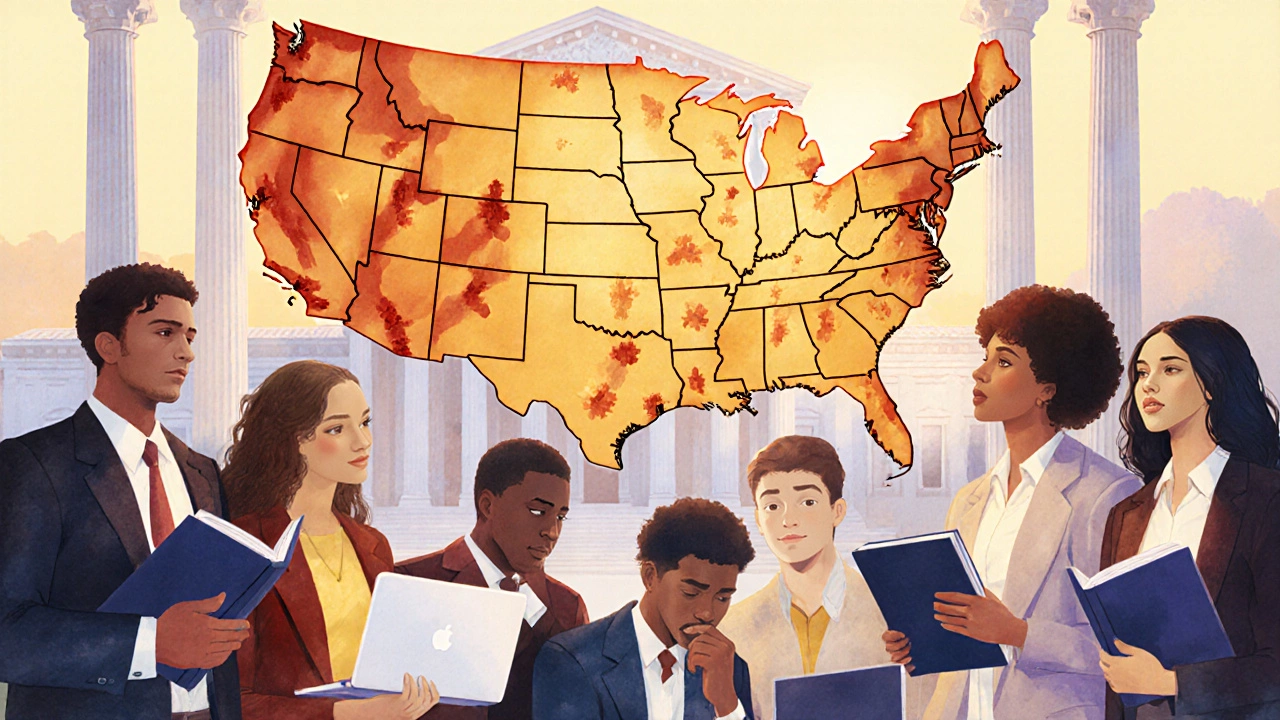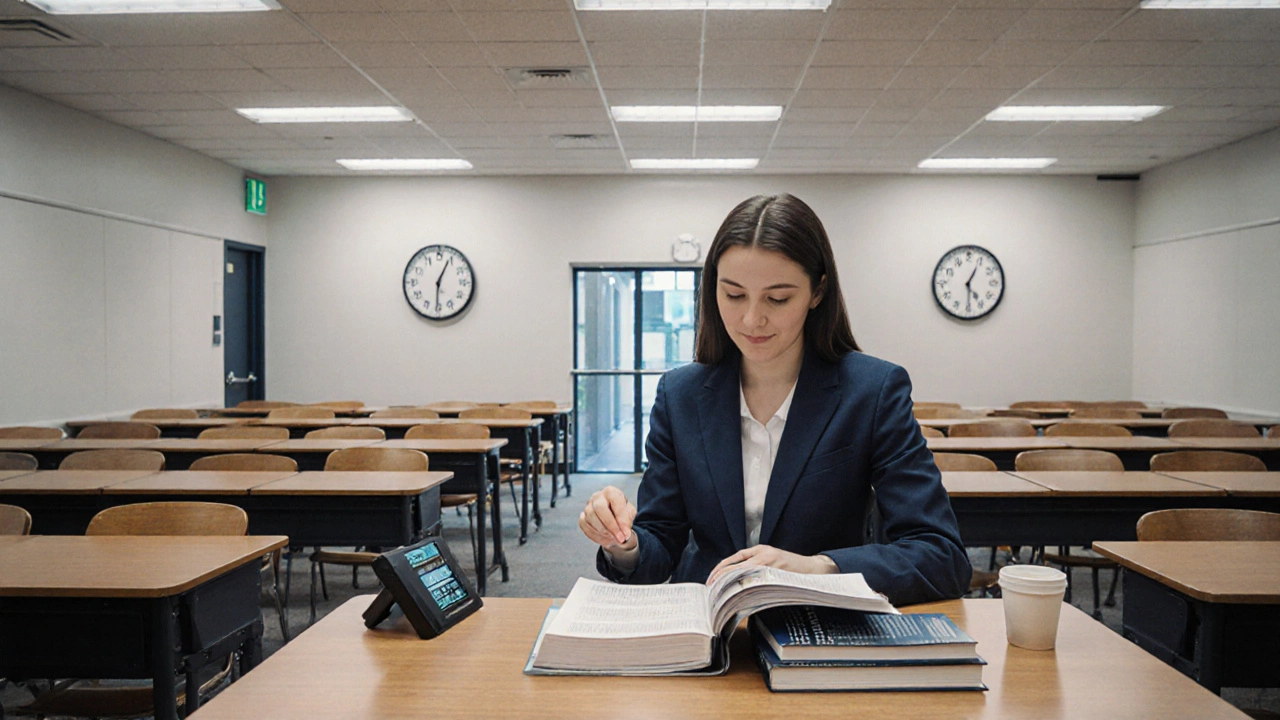
Bar Exam Difficulty Calculator
Select States to Compare
Difficulty Factors
The difficulty of becoming a lawyer depends on three key factors:
- Pass Rate 50% Weight
- Applicant Volume 25% Weight
- Additional Requirements 25% Weight
Results
Comparison Results
Most Difficult State
Select at least one state to compare difficulty.
Ever wondered which state makes it hardest to wear that lawyer badge? The answer isn’t just a trivia fact - it shapes where you decide to study, where you invest your prep money, and how you plan your legal career. Below we break down the data, the rules, and the real‑world tricks that separate the toughest jurisdictions from the rest.
Quick Takeaways
- California, New York, Texas, Florida, and Washington, D.C. consistently rank as the most difficult states based on bar‑exam pass rates and additional admission hurdles.
- Pass rates below 55% and high applicant volumes are the strongest signals of difficulty.
- Beyond the exam, states may require extra components such as a separate ethics exam, extensive moral‑character investigations, or state‑specific coursework.
- Choosing a tough state early means budgeting for longer prep, more review courses, and possibly retaking the exam.
- Use the checklist at the end to compare any state’s requirements before you commit.
Below is a step‑by‑step guide that lets you answer the core question: what is the hardest state to become a lawyer? We’ll look at the numbers, unpack the rules, and give you a practical roadmap.
How We Measure "Hardest"
Three core metrics drive our ranking:
- Pass Rate - the percentage of first‑time takers who pass. Lower rates signal tougher exams.
- Applicant Volume - more candidates usually mean stiffer competition for each testing slot.
- Extra Admission Requirements - separate ethics exams, state‑specific coursework, or intensive moral‑character reviews add layers of difficulty.
We pull the latest official statistics from the National Conference of Bar Examiners (NCBE) and each state’s bar administration for the 2023‑2024 testing cycles.
2023‑2024 Pass‑Rate Snapshot
| State | Pass Rate | First‑Time Applicants | Extra Requirements |
|---|---|---|---|
| California | 48% | 11,200 | California Professional Responsibility Exam (CPRE) |
| New York | 54% | 9,800 | NY Law Exam, Moral‑Character Review |
| Texas | 57% | 8,900 | Separate Ethics Exam, State‑Specific Course |
| Florida | 59% | 7,600 | Multi‑State Professional Responsibility (MSPR) Exam |
| Washington, D.C. | 60% | 3,200 | Three‑Year Law School Requirement, D.C. Law Exam |
The table makes it clear: California sits at the bottom with a sub‑50% pass rate and an extra state‑specific ethics test.

Why These States Are Tougher Than the Rest
Let’s unpack the three factors for each of the top five.
California
California Bar Exam is a six‑hour, two‑day test that includes the Uniform Bar Exam (UBE) portion plus the CPRE. The UBE itself combines the Multistate Bar Examination (MBE), the Multistate Essay Examination (MEE), and the Multistate Performance Test (MPT). California’s unique CPRE adds 100 multiple‑choice questions focused on state‑specific professional conduct.
- Large applicant pool: over 11,000 first‑time takers in 2023‑24.
- Low pass rate: 48% - the lowest among all UBE‑adopting states.
- High cost of living for law graduates, which can affect study time.
New York
New York requires the UBE but also adds the NY Law Exam, a 75‑question multiple‑choice test on New York-specific statutes and procedures. The state’s moral‑character investigation is famously rigorous, often taking months.
- Pass rate: 54% - better than California but still below national average (~70%).
- Extra NY Law Exam adds an extra hour of testing.
- Mandatory NY-specific coursework for out‑of‑state graduates.
Texas
Texas runs the UBE plus a separate Texas Ethics Exam (TEE). The state also requires at least 30 hours of Texas-specific legal subjects for out‑of‑state graduates.
- Pass rate: 57%.
- High applicant volume (≈9,000) and a reputation for tough essay grading.
- Strong emphasis on Texas procedural law.
Florida
Florida’s bar adopts the UBE and adds the Multistate Professional Responsibility (MSPR) exam, which is a distinct component not required in most other states.
- Pass rate: 59%.
- Florida’s separate MSPR exam often trips candidates who assume the UBE covers ethics.
- State‑specific discourse on real‑estate and immigration law adds to preparation load.
Washington, D.C.
Although D.C. is a small jurisdiction, it demands a three‑year accredited law school background and a dedicated D.C. Law Exam focusing on local statutes and administrative law.
- Pass rate: 60% - higher than the other four but still below the national average.
- Small applicant pool (≈3,200) means each seat is highly competitive.
- Additional D.C. Law Exam adds 75 multiple‑choice questions.
Beyond the Exam: Hidden Hurdles
Pass rates only tell part of the story. The following factors can turn an already tough state into a near‑impossible hurdle.
- State‑Specific Course Requirements - Some states (e.g., New York) demand a certain number of credit hours in local law for out‑of‑state graduates.
- Moral‑Character Review Duration - Lengthy background checks can delay admission for years, especially in California and New York.
- Continuing Legal Education (CLE) Obligations - A few states require a minimum number of CLE hours before you can even sit for the bar.
- Financial Barriers - Application fees in California exceed $900, and the cost of bar‑review courses can add $2,500‑$3,500.
Practical Tips If You Target a Tough State
- Start Early: Enroll in a dedicated bar‑review course at least six months before the exam. Courses that specialize in state‑specific sections (e.g., CPRE, NY Law) boost scores.
- Practice State‑Focused Questions: Use the state’s past exam questions. For California, the PRA (Practice Real Answers) database is a goldmine.
- Schedule Mock Exams Under Real Conditions: Simulate the two‑day format, including the extra ethics component.
- Prepare Documentation Early: Begin the moral‑character packet at least three months ahead to avoid delays.
- Budget for Retakes: Your first attempt may not succeed; having a financial cushion helps you stay focused.

Checklist: Compare Any State’s Difficulty
- Latest first‑time pass rate (2023‑24)
- Total number of first‑time applicants
- Existence of extra state‑specific exams (e.g., CPRE, NY Law Exam)
- Additional coursework or credit‑hour requirements
- Moral‑character review timeframe
- Overall cost (application + review course)
- Availability of state‑specific prep resources
Fill this checklist for any state you’re eyeing; you’ll instantly see where the biggest obstacles lie.
Frequently Asked Questions
Which state has the lowest bar‑exam pass rate?
California consistently posts the lowest first‑time pass rate, hovering around 48% in recent cycles.
Do all states use the Uniform Bar Exam (UBE)?
Most states have adopted the UBE, but several (including California, New York, and Texas) still add their own state‑specific components.
Can I take the bar exam in a state where I didn’t go to law school?
Yes, but many states (like New York and Texas) require additional coursework covering local law if your JD isn’t from an ABA‑accredited school within that state.
How much does a typical bar‑review course cost?
National courses range from $2,200 to $3,500. State‑specific add‑ons (e.g., California’s CPRE prep) can add $300‑$500.
Is it worth retaking the bar if I fail the first time?
Retaking is common. The average repeat‑taker improves their score by 7‑10 points, especially if they address the specific weaknesses identified in the first exam.
Next Steps
1. Choose the state you’re most interested in and pull its latest pass‑rate data. 2. Use the checklist above to map out extra requirements. 3. Budget for a dedicated bar‑review course that covers any state‑specific exams. 4. Begin your moral‑character documentation now-not after you register. 5. Schedule at least three full‑length mock exams before the actual test date.
By following this roadmap you’ll turn a daunting "hardest state" question into a clear action plan, giving you the best shot at becoming a licensed attorney wherever you decide to practice.







